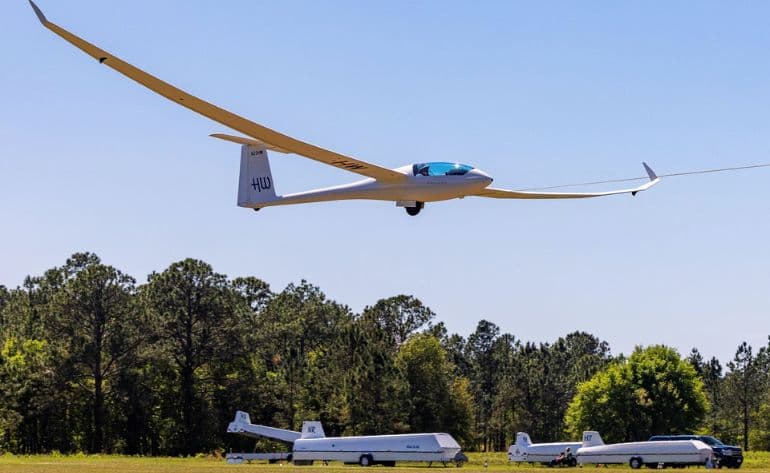
Glider Flights
Glider flying provides a sensation of freedom and lightness. Soaring above the most beautiful American landscapes, with the only sound being the air brushing over the fuselage, is an adventure you absolutely must experience.
After takeoff, towed by an airplane or launched by a winch, only the wind and thermals will be your engine. The United States is a fantastic playground for glider flying— a breathtaking experience.
Résultats
Glider flying provides a sensation of freedom and lightness. Soaring above the most beautiful American landscapes—such as our glider flight in Nevada (Minden-Tahoe)—with only the sound of the air brushing the fuselage is an adventure you absolutely must experience. After takeoff, towed by an airplane or launched by a winch, only the wind and thermal currents will be your engine. The United States is a fantastic playground for glider flying— a breathtaking experience. You could discover a glider flight in Southern California (Warner Springs) and soar over coastal and mountain scenery.
Flying a glider is a form of engineless flight where the aircraft, called a glider, uses air currents to stay aloft and move. The glider is launched either by aerotow with a tow plane or by winch. Analyzing and using thermal lift, ridge lift, or mountain waves makes it possible to gain altitude and remain in flight without an engine. The pilot must constantly adjust course and speed to stay in the air as long as possible. Glider flying is appreciated for the sense of freedom and tranquility it provides, as well as for the technical challenge of navigating without an engine.
Types of Glider Flights Available
Discovery Flight
Also called an introductory glider flight (first flight), this is the most common option. The flight generally lasts between 20 and 30 minutes, allowing the passenger to discover the unique sensations of engineless flight. Accompanied by an experienced pilot, they will explain the various flight techniques and showcase the region you’re flying over.
Introductory Lesson Flight
Unlike the discovery flight where the passenger is simply a spectator, the introductory lesson lets the passenger take the controls and get started with glider flying. Often preceded by a true pre-flight briefing and more in-depth explanations of piloting techniques and weather analysis, an introductory lesson often opens the door to full training to become a glider pilot—sure to spark vocations. Lesson flights usually last between 45 and 60 minutes.
Mountain Flight
This flight in a mountainous area lets you discover the glider in conditions that are particular and ideal for soaring, using lift generated by terrain. Besides the specific piloting skills for this environment, the discovery of mountain landscapes is spectacular.
Cross-Country Flight
The magic of gliding is the ability, depending on weather conditions, to fly long distances for long durations. The cross-country flight is ideal for those who want to make the most of the experience and discover an entire region from the sky.
The Best Places to Fly Gliders
Sierra Nevada (Western U.S.)
It’s a paradise for glider flying, with airfields like Minden-Tahoe (Nevada), Truckee (California), and Bishop—where a first glider flight truly shines. The Sierra Nevada offers exceptional flying conditions thanks to lift generated by the mountain terrain. The scenery is extraordinary and each season is different: snowy peaks in winter; lakes and valleys in summer. Long-duration flights are also possible, since the abundant sunshine in this region offers great potential—sunlight plays an important role in thermal lift.
Rockies (Front Range, Colorado)
At the edge of the Rockies, the Boulder/Longmont area offers a fantastic playground for glider flights. Thermal and dynamic conditions are excellent. Boulder is renowned for its strong lift and stunning scenery. Telluride is also an exceptional site known to glider pilots.
Southern California
In Southern California, glider flying lets you soar over spectacular Pacific-edge scenery, valleys, and desert areas. Weather conditions are often favorable, as at Warner Springs—where gliders launch and land right by the hills—and Hemet-Ryan near the San Jacinto Mountains.
Northeast (United States)
Soaring in the Northeast is a unique adventure that lets you discover its typical landscapes while feeling the freedom of a glider flight. Between New York State and Pennsylvania, first glider flights are a must-do. This region also offers the chance to fly at Harris Hill (Elmira, NY). Whereas glider flights normally use terrain lift, here the search for thermals is the most important part for the pilot during the flight.
How Does a Glider Take Off?
A glider needs external help to get airborne; only in flight can it stay aloft. Among the best-known launch techniques is the tow plane (aerotow). The airplane is attached to the glider with a cable; once at a satisfactory altitude, the cable is released and the glider continues its flight. Another common method is winch launch, where a ground-based cable rapidly accelerates the glider so it can take off.
How Does a First Glider Flight Work?
After arriving at the glider center, the pilot will explain the fundamentals through a pre-flight briefing before your introductory flight. Then comes boarding and takeoff. Once in the air, you’ll enjoy breathtaking views of the surrounding landscapes. After a certain time, depending on the option chosen, you’ll return to the airfield for a smooth landing.
How Long Is a Glider Flight?
Glider flights can last 20–30 minutes for introductory flights to several hours for long-duration flights. Of course, this depends on weather conditions, which play a major role in possible flight time.
How Does a Glider Fly?
A glider flies the same way an airplane does: air flowing over the wings creates the lift needed for flight. The difference is that without an engine, a glider needs external help to remain aloft—that’s where thermal lift and other air movements come in. The pilot must find these lifts to maintain altitude and even climb.
How Do I Prepare for a First Glider Flight?
Nothing special is required to take a glider flight—think warm clothing in winter and light clothing in summer. Choose casual attire and consider bringing sunglasses and a cap if it’s hot.
Find more activities available in the United States
Powered by our partner GetYourGuide



